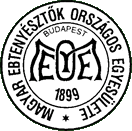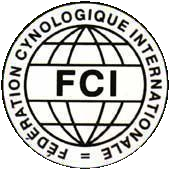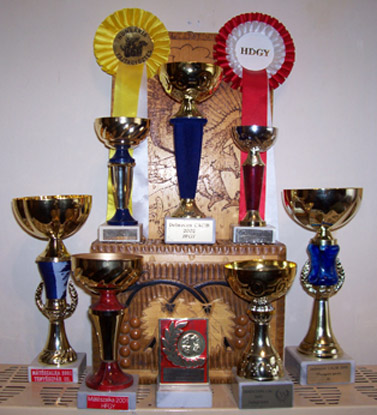A guarding dog, Moscow Watchdogs are strong and easy to train. Protection of the property and the people is in their blood. They do not mind living in flats. The Moscow Watchdog was bred on the Red Star military base outside Moscow. The breed descends from the long-hair St. Bernard and the Caucasian Ovcharka, and later the Russian Spotted Hound was also used for the cross-breeding. Russian military canine experts expended a lot of efforts to select the breeds with the desired properties.
General characteristics:
Moscow Watchdogs are large-size, massively structured, muscular dogs. They are perseverant, not very demanding as to their living conditions and are able to accommodate well to changes in the climate and other conditions. Their mood is well-balanced, and their nervous system is stable. They are wary of strangers, which makes them excellent and alert guards. They are ideal for outdoor guarding thanks to their hefty frame and thick hair that protects them even in the coldest weather. The ideal height of the dogs is 77-78 cm to the withers, and the bitches’ ideal height is 71-73 cm. The minimum height of the dogs is 68 cm, and of bitches 66 cm. Gender differences are pronounced.
HEAD:
Massive, wide skull, with a slight elevation at the forehead. The forehead is not protruding and is divided into two parts by a short line. The soft cheeks are somewhat shorter than the forehead. The cheeks are parallel to the forehead or slightly elevated. The teeth are thick. The cheek-bones are rounded and well-developed. The arch of the eyebrows is definite. The nape is massive but not easily discernible. The wings of nose are big and black.
EARS:
The ears are triangular in shape, the front edges lie closely to the head, and are connected to the head by cartilage. The bases of the ears are hefty and dark. The length and the width at the base are about the same.
EYES:
Medium-size, dark, round and forward-looking. The eyelids are black and dry.
TEETH:
Bulky, white and sit tightly. A healthy dog has 42 teeth. The bases of the incisor teeth are on the same level. Scissor bite.
NECK:
Massive, short, and positioned at an angle of 30-40 degrees to the back.
FRAME:
The chest is deep, broad and long. The ribs are round and widen at the back. At places, the fore-chest protrudes from the shoulder joint. The lower end of the chest is not high. The withers are high, broad, long, muscular and pronounced, especially in dogs. Ideally, the withers should be higher than the rump-bone. The back is straight, broad, muscular and strong. The two sides of the trunk are approximately identical. The waist is short, wide, muscular and not very prominent. The belly is tight.
FORELEGS:
Seen from the front, they are straight and parallel. The shoulder-blades are elongated. The front legs are at an angle of 100 degree to the shoulder bones. The shoulders are muscular. The lower half of the legs is straight, relatively long and massive. The elbows are pointed straight to the rear. The middle section of the legs is short, wide, strong and slightly inclined. The length of the forelegs to the elbows is 50-54% of the height to the withers. The paws are large and round.
HIND LEGS:
Seen from the back, they are straight and parallel. The thigh-bones are medium length with a slight bend. The shin-bones are almost the same length as the thigh-bones. From side-view, the angles of the elbows and the hocks point to the same direction. The middle section of the hind limbs is massive and almost vertical. The toes should be preferably standing slightly apart.
TAIL:
Wide, compact and positioned high. Its end reaches the hocks. When the dog is at ease, the hair on the tail is hanging downwards and the tail is slightly curved at the end. When the dog is excited, the tail rises over the backbone in a crescent shape.
HAIR:
Strong and thick, close to the body, with dense undercoating. The hair is shorter on the head and the front side. The hair is well-developed on the neck, especially in dogs. Dogs have a mane and a shaggy patch behind their ears. The hair is longer on the hind side of the shins and on the tail. Slightly wavy hair is acceptable.
COLOURS:
White and red, white and taupe, or white and russet, with spots. A “full coat” is preferred, that is, the chest, the collar, the forelegs to the knees, the hind legs to the shins, and half of the tail are white. Dark ears and a white band on the forehead are mandatory. Symmetrical black or dark brown face.
MOTION:
Typical motions are short trots and clumsy gallops. When the dog trots, the hind legs move in a straight line, and the forelegs approach the middle line. The joints of the legs may freely straighten. The back and the waist wave flexibly. The withers have to remain on the same level during trotting.
 Opening page >>>>> Opening page >>>>> |




 Opening page >>>>>
Opening page >>>>>



